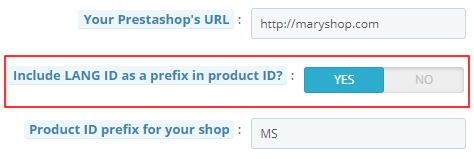Do I have to include the LANG ID in the product ID?
The module allows you to include or not the language ID in the products URLs (see the "Basic Settings" tab):

As a reminder, in your data feed, each product has a unique identifier (an ID) composed of a prefix identifying your shop (MS in the example above), a language identifier (LANG ID) and a number code corresponding to the product identifier in your back office:
For example, a product with the ID 5 in your PrestaShop back office, will have MSEN5 as ID in the english products feed.
Note: if you chose to export each product combination as a single product (new feature of the 1.3.0 version of the module), you will also have a code that indicates the combination, for example: MSEN5v1 for the first combination of the product with ID 5.
The detailed composition of this ID allows you to be extremely precise when you track the activity of each product or product combination. To know more, click here to read our dedicated FAQ.
When should the LANG ID NOT be included?
To be able to create dynamic remarketing ads, it's essential that product identifiers recorded by the pixel on your front office (on your site) match those of the products of your Business Manager catalog and therefore those of your products feed. However, there may be discrepancies depending on the language packs used.
- Indeed, in order to fill the LANG ID, the module uses the information from the language packs downloaded in your back office. In general, the language identifiers in the back office correspond to the language identifiers on the front office (on your site). However, especially for Hispanic languages, there may be discrepancies: a language identified as "Argentinean" in the back office may be identified as "Spanish" in the front office. The module will therefore send a product ID in the feed like MSAR5 but the pixel will read on the site, for the same product, the ID: MSES5.... There will then be a matching problem between the pixel data and the data in your Business Manager catalog and dynamic remarketing will not work.
To solve this problem, simply do not include the LANG ID in the feed product IDs by selecting "NO" for the "Include LANG ID as a prefix in product ID?" option:
- Another case where you may not have to fill either the LANG ID or the prefix identifying your shop (MS in the example above), is if before acquiring the module, you had already installed a pixel on your site and built audiences with the data collected. In this case, the product IDs recorded by the pixel are often "simple" IDs, i. e. they are only composed of a number code corresponding to the product IDs in your back office. When sending your product feed to the Business Manager with our module, you must therefore be careful to select "NO" for the option "Include LANG ID as a prefix in product ID?" and leave empty the box of the option "Product ID prefix for your shop" so that the product identifiers sent in the feed are only composed of the number code. This is the only way to have a correspondence between the pixel data, and so the previously built audiences, and the data of the product feed sent by our module. This will allow you to keep your audience history and use it to create ads.

- Finally, if you want to use country feeds so that your product data automatically adapts to the location of Facebook users (language, price, availability, etc...), you must not include the LANG ID in the product IDs. This is because Facebook takes care of matching the product data from the different feeds to the location of the users. If you include the LANG ID it will not work.

Other FAQs in this category
- Where to find my Business ID?
- How to create and install my Facebook Pixel?
- How to configure the module ?
- How to fill my shop's URL?
- What is the Conversions API and how to enable it in the module?
- How to automatically update my feeds (on-the-fly output or CRON task)?
- Do I have to ask the module to include the attribute IDs into combination URLs?
- How to choose the construction mode of product IDs in the feed?
- How to create custom labels to segment my catalog?
- How to match my products with Facebook categories?
- How to create advanced exclusion rules?
- Do I need to rewrite numeric values into the combination URLs?
- My shop uses multi-currency : how to make Facebook detect the correct currency?
- How to test my Pixel code?
- Should I include anchors in my product URLs?
- What is the Facebook "Advanced Matching" feature?
- I manage several languages/countries/currencies: How to use Facebook country feeds?
- How to tag products reserved for adults?